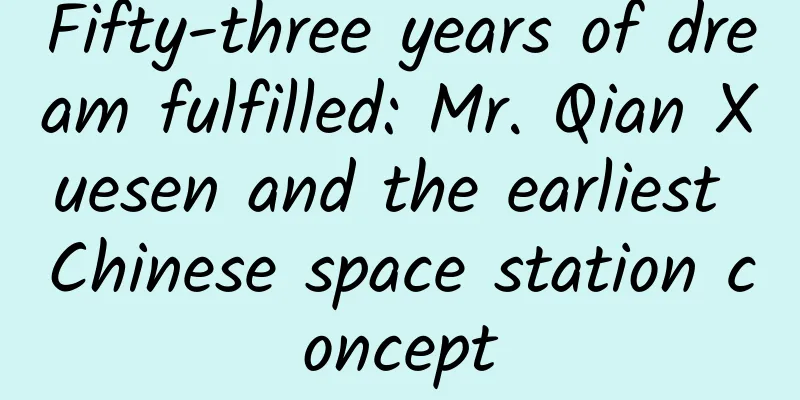Fifty-three years of dream fulfilled: Mr. Qian Xuesen and the earliest Chinese space station concept

|
Produced by: Science Popularization China Produced by: Li Huichao (Harbin Institute of Technology Shenzhen) Producer: Computer Network Information Center, Chinese Academy of Sciences On April 29, 2021, the Tianhe core module was successfully launched, which marked that the construction of China's space station has entered the right track and China's manned space program has reached the last step of the three-step plan. The composition of the Tianhe core module (Image source: authorized by @星智科创团队, the names of the components are marked by @冰结向日葵) But in fact, nearly thirty years ago, the predecessors who pioneered this business had already envisioned today's scenario. In the late 1980s and early 1990s, my country was discussing the planning of its manned space program. Building a space station was the ultimate goal of the foreseeable future manned space program at that time. The development of a new generation of rockets such as the Long March 7 and Long March 5, as well as the key technologies verified and achieved by various manned space missions, would ultimately serve this goal. However, the Chinese people’s dream of a space station did not begin when the central government approved the manned space program in 1992. "Ten-year development plan for artificial satellites and spacecraft (draft)", where the dream begins As early as 1968, there was another document that not only planned a 150-ton space station for China, but also proposed plans for reconnaissance spacecraft and fighter spacecraft, which now seem quite "science fiction". Although most of the plans proposed in this document, entitled "Ten-Year Development Plan for Artificial Satellites and Spacecraft (Draft)", were not implemented within the expected time due to the limitations of the comprehensive national strength and technological foundation at the time, it foresightedly pointed out the future direction for China's space industry, and those imaginative ideas at the time later became reality one by one. The leader and host of drafting this document was Mr. Qian Xuesen, a man who led China's space industry forward throughout his life but also dealt with "suspension" and "cancellation" throughout his life. Mr. Qian Xuesen is not only a hero in the development of the two bombs and one satellite, but also a banner for Chinese scientists (Photo source: CCTV News) A great scientist worried about a hose In 1959, in the United States east of the Pacific Ocean, rocket expert von Braun was busy with a series of rocket projects. Von Braun was the leader of the development of the V2 rocket in Nazi Germany during World War II. After being captured by the US military, he was reused due to his special status as a top rocket expert. Not only did he escape the trial of war crimes, but he also became a guest of honor of the Americans and led the development of US missiles and launch vehicles. In 1958, he led the design of the Juno 1 rocket, which successfully launched the first artificial satellite of the United States and the Western world, the Surveyor 1, into space. By 1959, he had already started to develop the Saturn 1 launch vehicle with better performance and began to imagine how to send astronauts to the moon. In that year, Mr. Qian Xuesen, who once interrogated von Braun as a representative of the US military, was on the other side of the Pacific Ocean worrying about a piece of hose. In April 1959, the Shanghai Institute of Mechanical and Electrical Engineering was working hard to develop the T-5 sounding rocket. Compared with the large rockets that the United States had successfully developed, the performance of this sounding rocket was very shabby. It was a "youthful version" of the German V2 rocket after being scaled down, and the takeoff weight of the entire rocket was only more than two tons. But even for such a seemingly simple small rocket, the development work could not move forward because of a hose: the boiling point of liquid oxygen is minus 183 degrees Celsius, but at that time, no unit in the country could produce a liquid oxygen hose that could withstand temperatures below minus 180 degrees Celsius. In addition to the problem of "a good cook cannot cook without rice", the Shanghai Institute of Mechanical and Electrical Engineering led by Mr. Qian Xuesen also faced the problem of "a penny can make a hero fail". At that time, the national economy was in trouble and the fiscal tightening had not provided much funds to support rocket development. Qian Xuesen (third from right) with students of the systems science seminar (Photo credit: China Academy of Space Systems Science and Engineering) The predecessor of Shanghai Institute of Mechanical and Electrical Engineering was the First Design Institute of the Chinese Academy of Sciences established in Beijing. It was a satellite and rocket general design and development organization established in 1958 to implement Chairman Mao’s call that “we also want to develop artificial satellites.” Originally, scientists and engineers were eager to launch our country's artificial satellite into space as soon as possible. But when these geniuses who were both imaginative and capable of execution examined the reality of the country, they had to come to the sad realization that the industrial system and national economy of New China, which had been built from scratch, were simply unable to support such a complex and comprehensive large-scale project as an artificial satellite. After the central government instructed in 1959 that "launching satellites is not commensurate with the national strength and that space technology research tasks must be adjusted," the Shanghai Institute of Mechanical and Electrical Engineering turned to developing less difficult sounding rockets. However, even for these products whose development difficulty has been greatly reduced, scientists still encounter many objective problems that are difficult to solve on their own in a short period of time. If Mr. Qian Xuesen had not returned to China... If Mr. Qian Xuesen had not chosen to return to his motherland, but continued to work in the United States, he probably would not have to worry about R&D funds and technical foundations such as cryogenic hoses. Due to the huge military value of missiles and rockets and the political need to engage in a space race with the Soviet Union, money was never a problem for aerospace in the United States at that time. In 1944, the U.S. military wanted to develop a plan for future air weapons tactics and missile development, and invited Mr. Qian Xuesen to participate as a core member. The U.S. military promised that "it doesn't matter how much money is spent" on the issue of funding. In the subsequent moon landing race, the United States poured more than $200 billion (converted to today's currency) into NASA, which is responsible for civil spaceflight, unprecedentedly. During the Apollo program, NASA's annual budget once accounted for about 4.5% of the federal government's total annual fiscal budget. It should be noted that this proportion is only about 0.5% now. Moreover, the United States had a complete and strong technological industrial foundation at that time, which was sufficient to turn scientists' ideas into reality as soon as possible. Take the development of a high-thrust rocket engine for the moon landing as an example. It requires the collaboration of many technical disciplines such as materials, metallurgy, machinery, chemical engineering, electronic information, and precision remote sensing and control. The US technology industry system was not destroyed during World War II, but instead developed greatly due to the stimulation of military orders. A large number of technology experts who came to the US voluntarily or involuntarily (such as German prisoners of war) from war-torn areas also injected new power into the US's post-war technology development. Von Braun (Image source: Wikipedia) Among the historical images of the Apollo moon landing program, there is a very symbolic photo: von Braun in NASA's office, with all the rockets he led to develop, from launching the first satellite to sending astronauts to the moon, behind him. Von Braun's name is also permanently linked to the Apollo moon landing because of his important role in rocket development. Qian Xuesen's mentor, the master of aerodynamics, John von Karman, once praised Qian Xuesen as "the greatest genius in the field of rocket technology in the United States." If Qian had not returned to China, who would have worked in that office? Choose to return to the motherland and choose to be a sower In that era when the country's strength could not support the "bold" ideas of scientists, all they could do was to work silently, sowing seeds for the future one by one, waiting for the day when there would be sufficient sunshine and rain, and the newly born sprouts would be able to grow into towering trees as soon as possible. Mr. Qian Xuesen is giving a lecture (Photo source: China Academy of Space Systems Science and Engineering) In 1958, when the development of artificial satellites and launch vehicles had just begun, Mr. Qian Xuesen realized that if he wanted to have better performing rockets in the future, he must conduct preliminary research on high specific impulse fuels. At that time, the development of high specific impulse fuels abroad was still in the exploratory stage, and there was no information to refer to. Under the leadership and auspices of Mr. Qian Xuesen, the Chinese Academy of Sciences built a high-energy fuel test base in Huairou. After exploration, they chose the liquid hydrogen/liquid oxygen fuel combination as the development direction. In the 1960s, the liquid hydrogen/liquid oxygen engine was initially developed. When the Long March 5 rocket roared into space, sending the Tianhe space station core module and the Tianwen-1 Mars rover into space, the two 50-ton liquid hydrogen/liquid oxygen engines on the first stage of the core provided the critical power, and their roots were in the test base built by Mr. Qian. The two manned spacecraft planned in the Ten-Year Plan are named "Qianjunbang No. 1" and "Qianjunbang No. 2", which have the functions of strategic reconnaissance of the earth and launching attacks in space respectively. Their names come from Chairman Mao's poem "The golden monkey raises the Qianjunbang, and the jade sky clears the dust", which is both romantic and expresses the mission of defending the country. In addition, a reusable space shuttle with a take-off weight of 50 tons and capable of flying back and forth between the earth is also planned. Mr. Qian Xuesen had proposed a preliminary idea for this type of spacecraft in 1949, which was to transform the V2 rocket into an aerospace plane capable of horizontal takeoff and achieve intercontinental rapid transportation by flying outside the atmosphere. This idea inspired the X-20 experimental aircraft in the United States and is considered one of the sources of the design ideas for the space shuttle that the United States later realized. However, developing these complex spacecraft was an almost impossible task for China at that time. When the central government approved the development of a manned spacecraft code-named "Shuguang" in 1970, the designers had to return to reality again and designed the spacecraft to be similar to the "Gemini" spacecraft used by the United States in the 1960s, capable of carrying two astronauts to perform a round-trip mission between the earth and the sky at one time. However, such a pragmatic plan had to be suspended in 1975 for various reasons. During the "Shuguang" project, the Institute of Aerospace Medicine and Engineering, which is directly related to human activities in space, was established. After the "Shuguang" project was suspended, the relevant departments once wanted to close the institute in order to save funds. It was Mr. Qian Xuesen who ran around and actively worked on various aspects, telling everyone that "going to space is an inevitable trend in the development of aerospace technology" and "if the 507 Institute is withdrawn now, it will be difficult to continue this business in the future." A few years later, when someone else wanted to take over the institute, the usually gentle Mr. Qian slammed the table. Now, the institute has become the Chinese Astronaut Research and Training Center. All Chinese astronauts who have traveled in space in the past, present and future are selected, trained and guarded by this institution throughout the flight. With the improvement of my country's comprehensive national strength and overall scientific and technological level, many of the far-sighted ideas in the "Ten-Year Plan" have gradually become reality. For example, the Lighthouse-1 and Lighthouse-2 navigation satellites planned in the "Ten-Year Plan" can provide navigation and positioning for my country's global navigation. In 2020, the "Beidou" global navigation and positioning system was completed, becoming a shining Chinese beacon in the sea of stars. After 2010, communication satellite platforms such as Dongfanghong-3B and Dongfanghong-4 were successfully developed and began to provide stable and reliable services. The idea of "ion rocket-propelled, large-capacity synchronous orbit satellites" planned in the "Ten-Year Plan" has been realized. Conclusion From Shenzhou V to Shenzhou VII, whenever an astronaut returned triumphantly from space, they would make a special trip to Mr. Qian Xuesen's home to report to him. Space hero Yang Liwei returns from his first flight and reports to Mr. Qian Xuesen (Photo source: CCTV Video) Mr. Qian Xuesen has witnessed with his own eyes that the seeds sown by him and other scientists of the older generation have grown into towering trees. The steel forest named "Dongfeng" they have cultivated protects the peaceful life of the people every day. Back then, the youngest professor at MIT returned to his underdeveloped homeland, giving up not only a comfortable life and a good income, but also many opportunities to associate his name with "human firsts" and many opportunities to have his work included in university textbooks. In 2009, when reporting the news of Mr. Qian Xuesen's death, many Western media simply attributed Mr. Qian's return to China to the prevalence of McCarthyism at the time. Mr. Qian Xuesen, who turned one year old, and his father Qian Junfu (Photo source: Approaching Qian Xuesen) However, what they don’t know is that when Mr. Qian left the country, his father sent him this message: "A person should have the qualities of a wise, benevolent, righteous, intelligent, loyal, fraternal and filial piety." "My son's journey to the west is not his long-cherished wish. He should return quietly and brilliantly." The sense of family and country is engraved in the bones of every true Chinese. Although the forms of expression and realization vary, it is the common pursuit of the descendants of Yan and Huang to make contributions, whether earth-shaking or unknown, to the prosperity and strength of their country. Image source: Animation "Year Hare Affair" References: 1. Qian Xuesen's Space Years, China Aerospace Press |
<<: It took several weeks to remove the parasite from the patient's body.
Recommend
Application of wearable devices: Suguang smart bracelet replaces fingerprint recognition
One is a sports bracelet, the other is a biometri...
How to create highly sticky products? Teach you 3 models
What is CLV? You must understand this word when m...
How much does it cost to join the Songyuan prenatal education mini program? What is the price for joining the Songyuan prenatal education mini program?
How much does it cost to join a prenatal educatio...
The camel, the "ship of the desert", was actually the most valuable pioneer before the beginning of the great voyages of discovery!
If you are trekking in the desert or in harsh env...
Why did he almost lose his life just because he was cutting his nose hair?
Many people like to trim their nose hairs, becaus...
Exclusive interview with Zeng Jian, senior web front-end engineer at Tencent: Node.js or H5?
With the continuous enrichment of mobile Internet...
How to find precise powder and how to add precise powder for free?
In today’s society, everyone can become an intern...
Don't treat "Chinese Valentine's Day" as "Valentine's Day" anymore! I am silent knowing the truth...
In recent years, every Chinese Valentine's Da...
How to improve brand loyalty through integrated marketing?
I will lead you to understand what marketing acti...
There is no UV ray in winter, but be careful about getting sunburned!
As winter approaches, many friends will ask, the ...
Analysis of the reasons why there are many bad keywords in the source of website traffic
A large number of banned words of unknown origin ...
How to improve the click-through rate of Guangdiantong ads? A few simple tips to teach you how to apply what you have learned.
When it comes to optimizing click-through rate , ...
Two women behind chaos science whose contributions should not be forgotten | Women in Mathematics Day
There are many examples in the history of science...
What are WeChat Mall, WeChat Mini Program, and WeChat Store? What are the differences?
Tencent has many products. Take the "WeChat A...









